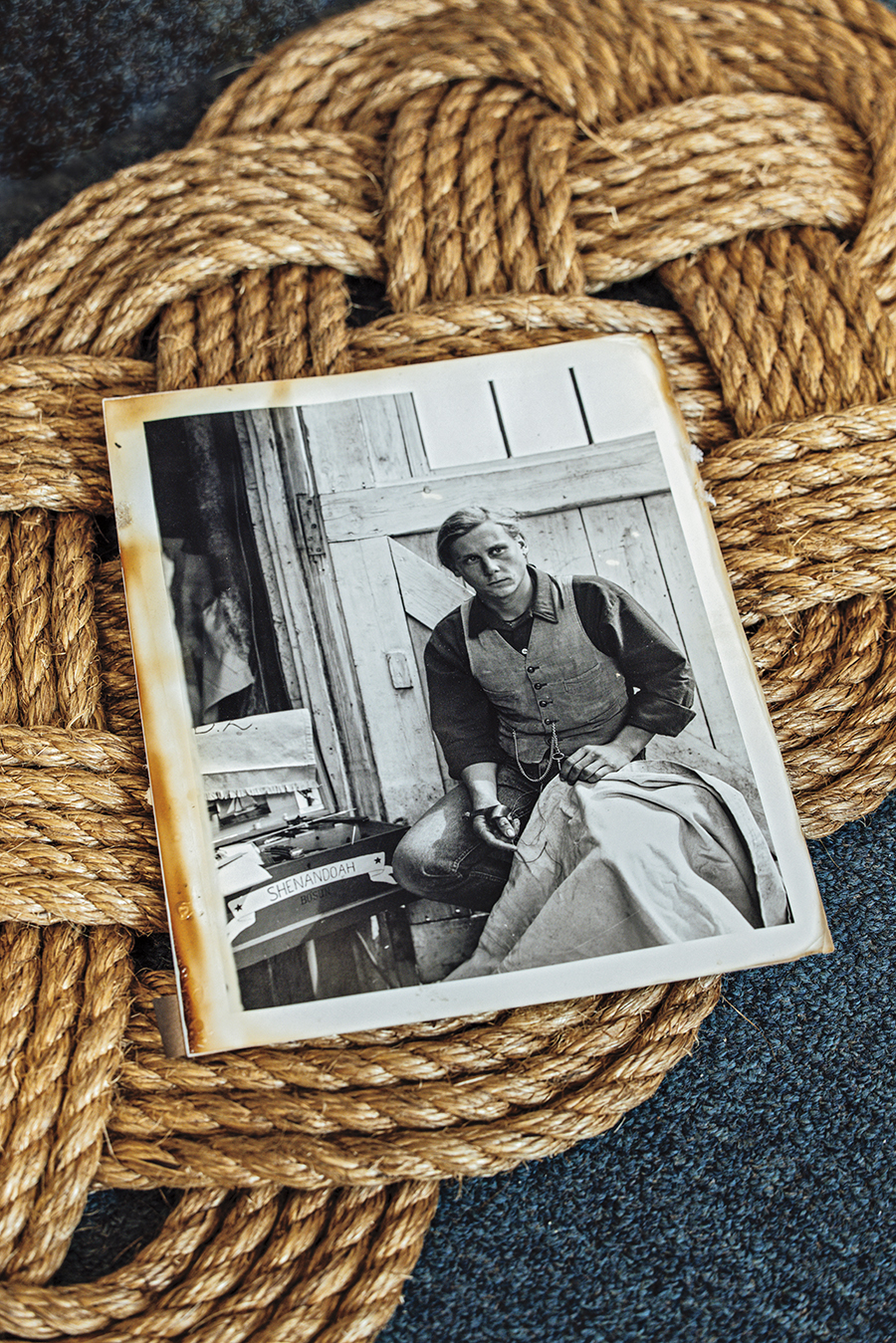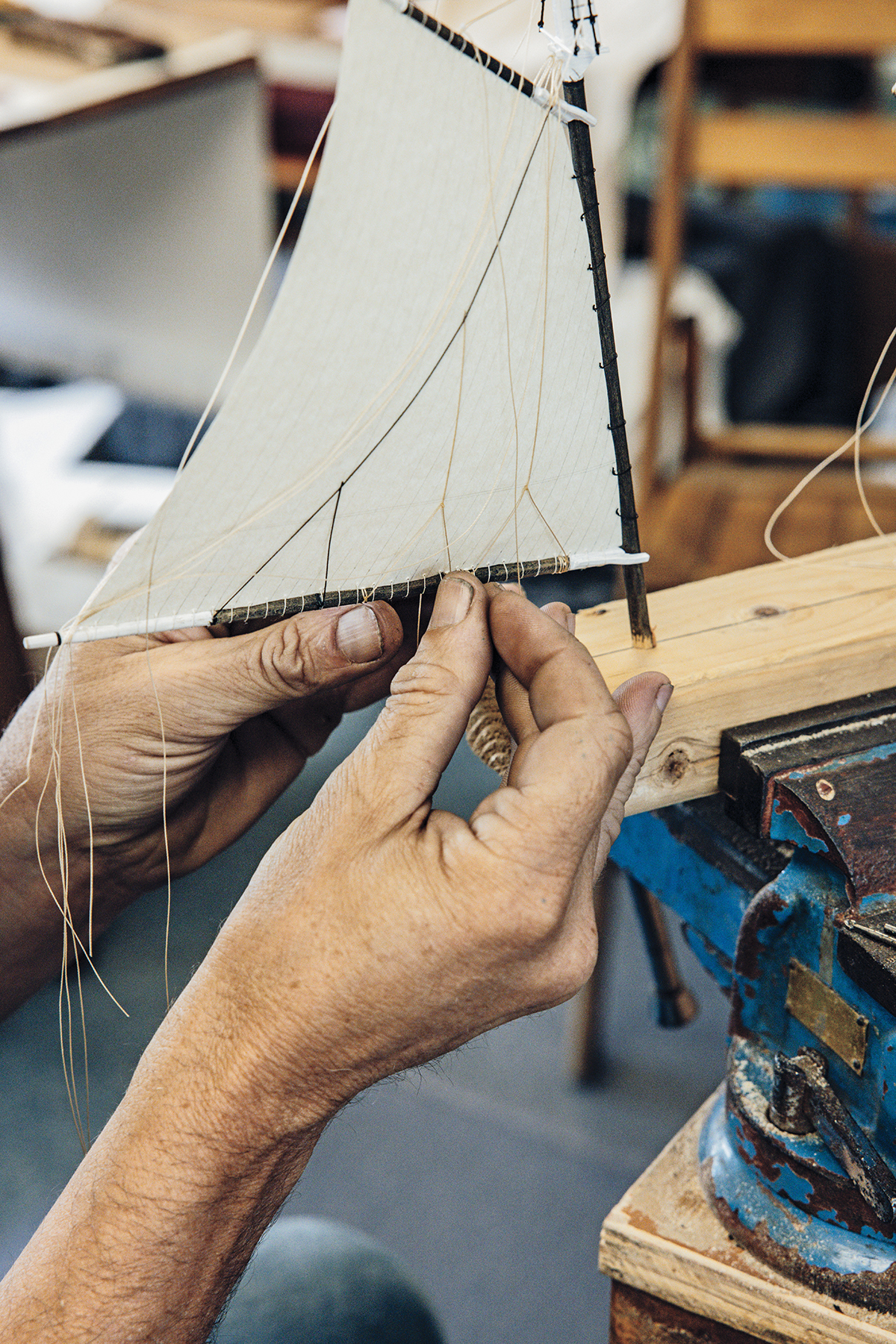Community Upraising
How a devastating fire rallied neighbors around Wickford Shipyard
By Elaine Lembo| Photographs by Jesse BurkeEvery turn along the waterfront of colonial Wickford Village takes the observer to another symbol of endurance: From church spire to homestead, mooring field to municipal office, this is a tight-knit Rhode Island community bound by history, marine traditions, modest charms, austere yet superb craftsmanship—and Yankee grit.
In the centuries-old tapestry of this iconic coastal town, the father and son duo of George and Dominic Zachorne are essential cross threads. Their brilliance and talent in many disciplines—from traditional wooden boatbuilding and restoration to marine ropework and a host of subjects nautical and otherwise—are an oasis in a world gone mad with speed and expediency. Their wellspring of goodwill and expertise, nonstop passion for accuracy and historical authenticity, and their bottomless appetite for the intricately unique and offbeat are what draw in those who encounter them.
If they look like they just walked off the set of another sequel to Pirates of the Caribbean, they can be forgiven because they’re not faking it. Once lured into their environment, a world replete with antique hand tools, working ship models, ivory and bone collectibles, logs of whaling ships, the smells of sawdust and linseed oil, and—for good measure—some well-honed senses of humor, many become hooked.
“They have a deep love for the history and heritage of this area, especially the nautical history,” says longtime friend Clay Berry, pastor of the Wakefield Baptist Church. “They’re a source of the kind of wisdom and encouragement that people need. And they’re the most generous souls I’ve ever met.”

Though in the initial aftermath, shock and grief and a sense of abrupt endings hung heavily over the collective psyche.
“The shop was a place of business, a museum, a social club,” says Jennifer LeComte, village resident and Dominic’s companion. “Treasures and relics of centuries past, gifted by respected idols or earned in trade—gone. These two men see their role in the world as caretakers of what otherwise would be lost—be it boats, antique tools, or old-time skill—and so this loss was cruelly ironic.”
In fact, in nearly two years since the fire—a conflagration that injured no one but incinerated the 20-year-old business, at least a half dozen boats, some 70 ship models, one-of-a-kind collections of stamps, first editions, rare prints and portraits, and antique craftsman’s tools—the galaxy of George and Dominic Zachorne, if fragmented, is still expanding.
On a sunny Saturday in spring 2021, soothing breezes and blossoms skittering over the water’s surface make for an intoxicating potion that temporarily dulls the memory of a jarring milestone. In the cockpits of their crafts tied to the shipyard docks, owners hang out, sipping coffee and mulling over the repairs that lie between them and their proper summer homes—the moorings in the inner harbor.
Wickford’s wooden boat fleet, a lingering nod to the town’s shipbuilding past, is a potpourri of rigs of all sizes and ages owned by devoted sailors of every stripe. The owners include this author, who decades ago met the Zachornes over a wooden 1928 Alden yawl named Morningstar. More recently, the Zachornes helped my other half, Capt. Rick Martell, and me care for Land’s End, a 1935 Crocker ketch.
“Wickford is an incredibly beautiful place, but it’s a whole lot more beautiful because it has an entire fleet of boats consistent with the aesthetic of the village,” says Irving Sheldon, aboard Sara Ann, his wooden yawl. “It adds a completely different dimension. Newport has it, Bristol has it. It’s an important part of our lives.”
Critical is the maintenance that keeps the fleet looking so good. The requirements for such diverse and aging hulls are constant. “Rot never sleeps” is a well-worn adage in these circles. Add to that an active schedule of racing, cruising, and fishing, and the Zachornes have, for decades, had their work cut out for them.
“They’re the reason the fleet is here,” says Ted Romanosky, owner of Good Fortune, a Crocker schooner built in 1939. Decades before their successful shipyard business, the Zachornes had already established a solid reputation for fine wooden boat craftsmanship in Wickford, at a small shop they opened in the 1970s at Pleasant Street Wharf. Berry puts it another way: “All these boats are under their care. They treat them like their children.”
Besides the rest of the fleet, father and son tend to their own. George is busy repainting the belowdecks interior of Ampelisca, his 1929 English pilot cutter. A few slips away, Dominic is kneeling at the side of his 1937 Alden cutter, Atea. Replacing its deck beams involves screwing in new fastenings, setting them with epoxy, then popping in new round wood stoppers, called bungs.
“My poor boat is 84 years old,” Dominic says as he works. “It’s amazing it’s still floating.”
A spot-on portrayal of contemporary Wickford, its people and their motivations, comes from longtime resident and writer Greg Coppa. Second Chances, his 2018 novel, draws liberally from fact to paint a portrait of the quintessential waterfront New England village.
The main character, Skip, sails under an assumed identity back to his childhood home from the Caribbean. The town “stranger” joins an informal crew building a fancy wooden picnic boat for a wealthy owner. “Skip just had an urge to pick up a tool and join in,” Coppa writes. “A boat being built, though, has that effect on many men.”
In real life, Dave Esau is one of those men. The retired quahogger, a talented carpenter, was working out of the Zachornes’ shop for nearly three years, restoring a classic wooden MacKenzie day cruiser for his childhood pal, Steven Antaya. Antaya, a longtime customer, had kept a couple of boats in the shop, and Esau was picking up tips of the trade from George and Dominic as he worked on the cruiser. The boat was weeks away from launching the day of the fire.
“David made it into a work of art,” recalls Antaya. “It was irreplaceable. David poured his heart and soul into it. It came out beautiful. But nobody owes anybody anything. George and Dominic can continue to work on their boats and the models and work with what they have. It’s just a bump in the road, really. You become—not whole again—but you just pick up where you left off. There’s plenty of work. Everybody’s still here. Thank God nobody got hurt. It’s just a bunch of stuff that’s gone.”
Despite their own losses in the fire, Esau, Antaya, and the rest of the community were more concerned with the Zachornes’ welfare.
“People just pull together and help out. Somebody drops off firewood, somebody bakes a cake. They mobilize. After the fire, people were saying, ‘What are we going to do to help them?’” Coppa says. “They are such an important part of boating and the community at large.”
“I’ve always felt that one of the reasons that people are so close to them, besides the fact that they’re just nice guys and bend over backwards to help you out,” he says, “is that they’re a link to the past—the 18th and 19th centuries. George could build any of the boats that used to be built on the banks of the harbor, and Dominic can rig and sail a boat wherever it needs to be sailed. They’re encyclopedic in their knowledge in the techniques of boatbuilding. It is a living history lesson to be around them, and people recognize how lucky we are to have them in our lives.”
“Maybe 30 people came in and sorted through the ashes, pulling out salvageable tools and possessions,” Coppa says. “It was heartwarming to see that kind of response.”
The effort became a race against the summer heat and corrosion. “People I never knew before and haven’t seen since showed up,” says Esau. “You’d start in the morning with clean clothes, and you’d end in the afternoon completely black, full of soot and grease. The neighborhood and village really came together and were very supportive, from buying us pizza for lunch to cold drinks, and helping clean the tools.”
Then the town merchants got into the act. The Shipyard Shindig in October 2019 drew a merry crowd of a thousand to Duffy’s Tavern, with live music, donations of food, and raffle prizes.
Planning committee members were town merchants and Stuart Tucker, owner of Duffy’s. All proceeds from the fundraiser went to the Zachornes and Coastal Iron Works.
“It was breathtaking to see how the community came together for them,” says Berry, who spends days off from his church helping the Zachornes. “It says a lot about who they are, the connections they’ve made, what they do for people. It was very healing for them.”
Since then, shipyard owner Wes McKeen and his sons, and the late Don Fraser, the previous longtime owner, have ensured the Zachornes had a place to work. George set up two containers near the sheds on the property. At first, LeComte made room for Dominic’s ship modeling work at her home in the village. Then McKeen offered Dominic a part-time job at the yard hauling boats. He also gave him a good-sized office space, where he could resurrect the ship model and ropework art businesses and sell to the public.
Gifts of tools, books, equipment, and artifacts started to accumulate anew, alongside serious overtures and offers of shop space, business investment, and most importantly, new commissions for model making and full-size boat restoration and repair.
Mary Ann Naddy, who lives behind the shipyard in the Poplar Point neighborhood with her husband, Onno Boswinkel, was one of the early volunteers who helped with the salvage. As her friendship with Dominic grew, she started making sails for his models. Antaya purchased our ketch, Land’s End, and put Esau immediately to work on the ongoing restoration of the 85-year-old girl who remains so dear to us but requires more than we can keep giving her.

While George and Dominic easily talk about the fire, it’s not something they like doing. Our decades-long friendship with them is why they tolerate my questions on that spring Saturday, when they really need to be working on their boats. Mention silver linings and George is philosophical and emotional.
“It’s a little difficult,” he says haltingly, through tears. “To me, the best thing that came out of the fire was the response from the community. I have trouble understanding what we’ve done to deserve that sort of response, but I think it was an incredible thing that happened. It really makes you enjoy living in a small town like this, with people like this.”
Even two years later, he’s taking time to decide his next moves and weighing upsides and downsides of managing a shop in town again, versus setting up in the barn at his antiques-rich family homestead in Shannock, a village in Charlestown. One thing is certain:
“Working out of a container is miserable,” he laughs. “The work bench moves, sawhorses fall over. It’s like cooking on a hibachi outside when you’re trying to bake a birthday cake.”
“I could outfit another shop in the same way as the one we had at the shipyard,” he says. “I’ve always enjoyed using antique tools and doing things in an old way. And I keep track of things. The things around me are antiques. We own them, we use them, and we take care of them. Ultimately, we have to pass them on because they’re going to outlive us.
Sooner or later, you have to find somebody to pass these irreplaceable items on to. I feel that way about a lot of older things, including boats,” he says. “I’m the 6th owner of Ampelisca, but I’m not going to be the last owner.”
At the end of each day, the picture becomes clearer. “You have to keep moving,” he says.
“You can’t stop. You can feel bad about it for a little bit, but you need to do what you can to keep moving. A lot of people ask about the fire—it was bad. Yeah, I feel beat up by it. It’s not the worst thing that’s happened to me. All we lost is a collection of stuff. Some of it can’t be replaced but a lot of it can be. If you’re healthy, you can do anything. You can work, do all sorts of things. Everything else is just a problem to be dealt with.”
While Dominic, who’s 48, holds a similar view, his options are different. In wiping out his precious collections, the fire also brought priorities into focus. First, he finished Slop Chest, the acclaimed memoir of his experiences working aboard the celebrated schooner Shenandoah of Martha’s Vineyard.
The book is now part of the Rhode Island history collection at the North Kingstown Library and in the library of the Martha’s Vineyard Museum.
“There are countless books about sailing ships filled with beautiful, glossy photographs and sleek, glossy text. There are far too few that, with the voice of experience, relate ‘how it is’ aboard a working sailing vessel. Slop Chest is a worthy addition to those few,” writes research librarian A. Bowdoin Van Riper in a letter to Dominic.
The fire has “definitely created a fresh start,” Dominic says as he works on Atea’s decks. “I’m looking more at where I’ve gotten to and where I’d like to
end up. I’ve always enjoyed working on the models and creating the nautical antique ropework and other items. That opportunity has been handed to me.
You can stop, reconsider, and reorganize. That’s true. Fortunately, I’m cursed with [being] capable and have a tendency to become entangled in projects deemed impossible. It sort of creates a demon. Somebody says, ‘Well, you did that, you can do this.’ It piles up.”
As far as the boat owners and villagers of Wickford are concerned, these two treasured souls will always have a place and a means to ply their trade and let the stuff pile up. “Their talent, their art, their ability to restore boats sets them apart,” says Sandy Collins of Pleasant Street Wharf. “It’s a love, a passion, and it’s respected.”
Contact Us
Telephone: (401) 874-6805
Email: allard@uri.edu
Contributor Guidelines
Please review submission guidelines to be considered. d


